Software Development, Finance and AI
We’ve been doing Software Development and Architecture work for a while at Snowpal, and currently have several B2B and B2C products in production. In this podcast, we’ll share our experiences on a regular basis to help you & your teams build great software. The topics covered in this podcast will include Product Management, Project Management, Architecture, Development, Deployment, Security, Release Management, Sales, Marketing, Advertising, and just about everything else an ambitious, fast growing startup based out of the US is likely to be involved in. So, join us. Let’s become better!
Episodes
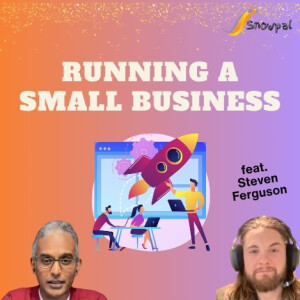
Monday Nov 25, 2024
Running a Small Business (feat. Steven Ferguson)
Monday Nov 25, 2024
Monday Nov 25, 2024
In this episode, Steven Ferguson shares his journey from being a Marine to becoming a successful entrepreneur. He discusses the importance of integrating a social mission into business, the challenges of bootstrapping a startup, and the significance of thorough planning and research. Steven also delves into the intricacies of managing an e-commerce business, particularly in the coffee industry, and the various challenges he faces, both technical and non-technical. He emphasizes the need for expertise in areas where one lacks knowledge and the importance of effective marketing strategies for growth.
Steven discusses his transition from a custom-built e-commerce platform to Shopify, highlighting the benefits of ease of use and cost-effectiveness. He emphasizes the importance of focusing on the core business of selling coffee while navigating technical challenges. The discussion shifts to marketing strategies, where Steven shares insights on effective customer engagement through events and digital marketing. He also reflects on the journey of becoming a founder, addressing the expectations versus the reality of entrepreneurship, and the significance of having a mission-driven business.
Takeaways
• Businesses should not only prioritize profit but also people.
• Bootstrapping a startup requires careful resource management.
• Planning is essential for any new venture.
• Choosing the right business model can make or break a startup.
• E-commerce presents unique challenges compared to traditional retail.
• Finding the right suppliers is crucial for product quality.
• Marketing strategies must adapt to the digital landscape.
• Customer service is vital for maintaining growth.
• Automation can streamline operations but requires initial manpower.
• Using pre-built platforms can save time but may limit customization.
• Transitioning to Shopify resolved many technical issues.
• Focusing on the core business is crucial for success.
• In-person marketing at events yields high conversion rates.
• Digital marketing presents challenges but is essential for growth.
• Understanding customer demographics helps target marketing efforts.
• The mission of supporting veterans is a key selling point.
• Customization in e-commerce can be both necessary and limiting.
• Building a brand message around a social cause resonates with customers.
• The journey of a founder involves continuous problem-solving.
• Flexibility in daily tasks is both a freedom and a responsibility.
Chapters
00:00 Introduction to Steven Ferguson and His Mission02:52 Integrating Social Mission into Business Models06:10 Bootstrapping a Startup with Limited Resources09:11 Planning and Research for New Ventures11:55 Choosing the Right Business Model15:04 Navigating E-commerce and Physical Products18:06 Managing Supply Chain and Inventory21:03 Overcoming Challenges in E-commerce24:02 Marketing Strategies for Growth26:50 Technical and Non-Technical Challenges in Business32:54 Transitioning to Shopify: A Strategic Move41:50 Marketing Strategies: Connecting with Customers53:25 The Journey of a Founder: Expectations vs. Reality
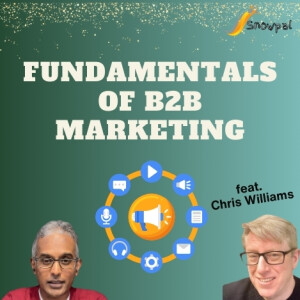
Monday Nov 25, 2024
Fundamentals of B2B Marketing (feat. Chris Williams)
Monday Nov 25, 2024
Monday Nov 25, 2024
In this episode, Krish Palaniappan interviews Chris Williams, CMO at Arima, discussing the evolution of marketing strategies, particularly focusing on marketing mix models and their application in both B2B and B2C contexts. Chris shares insights on how startups can effectively market their products, identify key stakeholders, and leverage content creation and community engagement to build their brand. The conversation also touches on the role of a CMO in a startup environment and the challenges faced in prospecting and utilizing paid search effectively.
Krish and Chris discuss the multifaceted roles of founders in startups, particularly in marketing and sales. They explore the importance of understanding customer problems, effective budgeting strategies, and the dynamics of sales and marketing. The conversation also delves into the challenges of educating customers about solutions, handling rejections in sales, and crafting effective elevator pitches. Chris emphasizes the need for a balance between product development and marketing efforts, highlighting that both art and science play a role in successful marketing strategies.
Takeaways
• Marketing mix models have evolved significantly over the years.
• Understanding your target market is crucial for effective marketing.
• Building relationships is key to acquiring initial customers.
• Identifying influencers within organizations can drive product adoption.
• Content creation is essential for engaging potential customers.
• Paid search remains a valuable tool despite changing landscapes.
• Startups often require a different approach to marketing than established companies.
• Networking at events can expand your reach significantly.
• Utilizing LinkedIn effectively can help identify prospects.
• The role of a CMO in a startup is multifaceted and dynamic. The founder often serves as the best CMO in a startup.
• Understanding customer pain points is crucial for effective marketing.
• Budgeting in startups should be flexible and responsive to traction.
• Sales and marketing should begin as soon as the entrepreneurial journey starts.
• Prospecting is a key component of the sales process.
• Handling rejection is part of the sales journey and should not be taken personally.
• An elevator pitch should be tailored to the audience when possible.
• Marketing is essential to keep the product development on track.
• Sales strategies should include relationship building and networking.
• Both quantitative and qualitative measures are important in marketing.
Chapters
00:00 Introduction to Synthetic Data and Marketing Mix Models02:52 Understanding Marketing Mix Models05:56 Marketing Strategies for Startups08:55 Identifying Stakeholders and Influencers12:02 Prospecting and Finding Influencers14:47 Content Creation and Community Engagement18:11 Paid Search and Its Evolving Landscape21:00 The Role of a CMO in Startups37:18 The Role of Founders in Startups40:35 Budgeting Strategies for Startups42:14 Understanding Customer Problems45:06 Educating Customers on Solutions49:44 Sales and Marketing Dynamics52:50 Sales Strategies and Techniques56:21 Handling Rejections in Sales01:01:26 Crafting the Perfect Elevator Pitch01:04:10 Balancing Development and Marketing01:06:53 Final Thoughts and Comfort Food
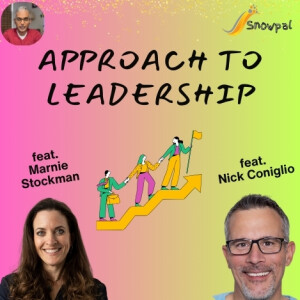
Thursday Nov 21, 2024
Approach to Leadership (feat. Marnie Stockman & Nick Coniglio)
Thursday Nov 21, 2024
Thursday Nov 21, 2024
In this episode, Krish Palaniappan, Marni Stockman, and Nick Coniglio discuss their journey as founders of Lifecycle Insights, a SaaS platform. They explore the importance of leadership, the challenges of starting a business, and the critical role of sales and marketing. The conversation delves into the significance of validation in product development and effective strategies for gathering honest feedback from potential customers. The hosts emphasize the need for iterative development and the importance of understanding customer needs to ensure business success.
Nick Coniglio and Marnie Stockman discuss the critical aspects of leadership, stakeholder management, and the importance of character skills in the startup environment. They emphasize the need for identifying key stakeholders, understanding the fluid nature of gatekeepers, and the significance of leading oneself, especially in small teams. The discussion also covers the learning curve associated with leadership, the mistakes made along the way, and how to navigate leadership in a diverse and remote work environment. Ultimately, they highlight that character and communication are essential for effective leadership in today’s world.
Takeaways
• Founders should focus on building relationships and communication.
• Sales and marketing are essential for business growth.
• Validation is crucial before launching a product.
• Engaging with the user community leads to better product development.
• Iterative development allows for continuous improvement.
• Listening to customer feedback is vital for success.
• Sales should be integrated into the product development process.
• Asking the right questions leads to valuable insights.
• Detaching from your product helps in receiving honest feedback.
• Understanding your target market is key to validation.
• Identifying key stakeholders is crucial for product success.
• Leadership is essential, even for small teams.
• Everyone is a leader in their own right.
• Leadership skills can be learned and developed.
• Character skills are becoming increasingly important.
• Good leadership focuses on team growth and development.
• You cannot please every user; focus on core needs.
• Mistakes in leadership provide valuable learning opportunities.
• Communication is key to effective leadership.
• Be open to feedback and adapt your approach.
Chapters
00:00 Introduction to Leadership and SaaS03:22 Founders’ Journey: From Employees to Entrepreneurs08:45 The Birth of Lifecycle Insights14:36 Writing a Book: Sharing Experiences20:47 Sales and Marketing: The Lifeblood of Business25:10 Understanding Validation in Startups31:01 Effective Validation Strategies37:15 Asking the Right Questions for Validation41:12 Identifying Key Stakeholders48:00 The Importance of Leadership in Startups53:10 Learning from Leadership Mistakes57:48 Navigating Leadership in a Diverse World01:01:00 The Role of Character in Leadership
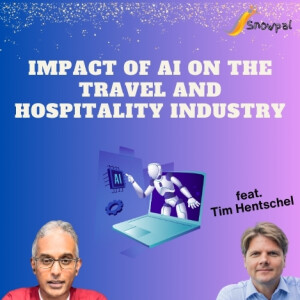
Wednesday Nov 20, 2024
Impact of AI on the Travel and Hospitality Industry (feat. Tim Hentschel)
Wednesday Nov 20, 2024
Wednesday Nov 20, 2024
In this episode, Krish Palaniappan interviews Tim Hentschel, co-founder and CEO of Hotel Planner, discussing the impact of artificial intelligence on the travel and hospitality industry. Tim shares insights on the evolution of group hotel bookings, the unique offerings of Hotel Planner, and the integration of AI in call centers. The conversation also delves into technology licensing, customer interactions with AI agents, and the challenges of selecting the right technology in a rapidly evolving landscape. In this conversation, Tim Hentschel discusses the integration of AI in business operations, the evolving role of engineering teams, and the challenges of staffing in startups. He emphasizes the importance of understanding the dynamics of entrepreneurship, especially in the context of AI, and shares personal insights on comfort food and the realities of running a business without external funding.
Takeaways
• Tim Hentschel is a third-generation hotelier with a background in computer science.
• Hotel Planner specializes in group hotel bookings, automating the process significantly.
• The company has patented technology for group bookings that simplifies negotiations with hotels.
• AI agents are trained on over 8 million calls to enhance customer interactions.
• Hotel Planner operates under the corporate name Lexel Technologies, focusing on technology licensing.
• The AI agents can handle individual and group bookings, providing personalized experiences.
• The integration of AI in call centers has improved conversion rates by 30%.
• AWS plays a crucial role in hosting Hotel Planner’s gig-based system.
• Choosing the right technology is essential to avoid over-engineering solutions.
• Tim emphasizes the importance of high touch and high automation in the travel industry.
• AI is transforming business operations and customer interactions.
• The scalability of AI can provide a competitive advantage.
• Engineering teams are adapting to new AI tools without reducing headcount.
• Staffing strategies should focus on quality over quantity in tech roles.
• Entrepreneurship requires resilience and a clear vision beyond financial gain.
• The survival rate of startups is alarmingly low, especially in AI.
• AI can enhance personalization in customer service significantly.
• Raising funds can dilute founder equity and control.
• Comfort food preferences can reveal personal insights about individuals.
• Understanding market dynamics is crucial for startup success.
Chapters
00:00 Introduction to Hotel Planner and AI in Travel03:07 The Evolution of Group Hotel Bookings05:57 Understanding Hotel Planner’s Unique Offerings08:53 Technology Licensing and Customer Base12:12 AI Integration in Call Centers14:57 Exploring AI Agents and User Interaction17:55 Technology Architecture and Implementation20:46 Challenges in Technology Selection28:25 The Evolution of AI in Business Operations32:15 Engineering Teams and AI Integration39:44 Staffing Strategies for Startups43:45 Entrepreneurship in the Age of AI50:30 Comfort Food and Personal Insights
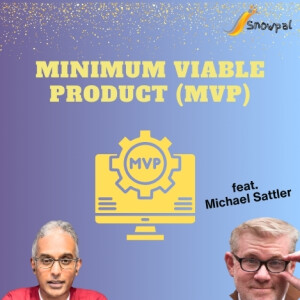
Wednesday Nov 20, 2024
Minimum Viable Product (feat. Michael Sattler)
Wednesday Nov 20, 2024
Wednesday Nov 20, 2024
In this episode, Krish Palaniappan and Michael Sattler delve into the concept of Minimum Viable Product (MVP). Michael shares his extensive experience as a serial entrepreneur and fractional technical product executive, discussing the evolution of his understanding of MVP over the years. The conversation covers the definition of MVP, common misconceptions, the importance of recognizing team capabilities, and the necessity of proving value through MVPs. They also explore the concept of MVP in non-engineering contexts, such as opening a restaurant, and the relationship between MVP and product-market fit. The episode emphasizes the iterative nature of MVP development and the importance of user feedback in refining the product.
Takeaways
• MVP is the smallest feature set to prove value.
• Aesthetics matter only if they communicate value.
• Founders often confuse their vision with user needs.
• Recognizing team capabilities is crucial for MVP success.
• MVP should be a test of hypotheses about user needs.
• Iterate based on user feedback to improve MVP.
• MVP can be applied in various contexts, not just software.
• Product-market fit is different from MVP.
• Cutting unnecessary features simplifies MVP development.
• Learning from MVP failures is essential for growth.
• MVP should be designed to teach rather than be perfect.
• Finding product-market fit is crucial for startup success.
• Startups often fail due to lack of market validation.
• Testing ideas before building can save resources.
• It’s essential to identify the most critical features first.
• Big companies also struggle to identify valuable features.
• Startups can learn from the testing methods of larger companies.
• Understanding customer needs is vital before building an MVP.
• The process of building an MVP should be iterative and flexible.
• Feature selection is both an art and a science.
• Building something beautiful for personal satisfaction is valid.
• Skepticism is crucial in evaluating your own ideas.
• Validation from friends is often just sympathy, not real feedback.
• Understanding consumer willingness to pay is essential for success.
• Simulating the buying experience yields more valid data.
• Execution is as much a science as it is an art.
Chapters
00:00 Introduction to MVP and Michael Sattler's Background02:16 Defining Minimum Viable Product (MVP)06:42 Common Misinterpretations of MVP09:33 Recognizing Team Capabilities in MVP Development12:55 The Importance of Proving Value in MVPs15:47 Exploring MVP in Non-Engineering Contexts20:46 Understanding Product-Market Fit vs. MVP24:35 Iterating on MVP Based on User Feedback29:45 Defining the Minimum Viable Product (MVP)32:43 The Importance of Product-Market Fit35:19 Alternative Approaches to Feature Development39:41 Testing Before Building: The Agile Approach43:36 Learning from Big Companies: What Startups Can Do48:34 Understanding Product-Market Fit vs. Problem-Solution Fit51:55 Translating Restaurant Validation to SaaS56:39 The Art vs. Science of Feature Selection01:04:53 The Joy of Building for Personal Satisfaction01:05:47 The Importance of Skepticism in Entrepreneurship01:08:04 The Reality of Validation and Market Testing01:11:41 Understanding Consumer Willingness to Pay01:18:45 Execution: The Science Behind Successful Startups01:19:45 Looking Ahead: Future Conversations on Execution Challenges
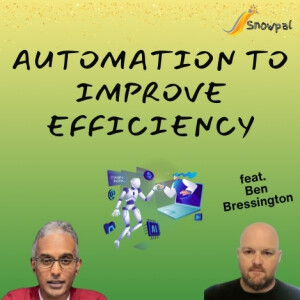
Tuesday Nov 19, 2024
Automation to Improve Efficiency (feat. Ben Bressington)
Tuesday Nov 19, 2024
Tuesday Nov 19, 2024
In this episode, Krish Palaniappan interviews Benjamin Bresington, CEO of Automate Boring, about the transformative power of automation and AI in business. They discuss the challenges of scaling a company, the intricacies of Robotic Process Automation (RPA), and real-world applications that demonstrate how automation can streamline processes and enhance productivity. Ben shares insights into the technology stack used for automation, the importance of understanding client needs, and the potential for automating course creation processes. Ben discusses the transformative impact of AI and automation on course creation, software development, and business processes.
Ben emphasizes the importance of integrating AI into existing platforms, scaling operations through automation, and the necessity of documenting processes for effective onboarding. The discussion also covers the evolution of software development practices, the optimization of code reviews with AI, and the cultural shifts required in engineering teams to embrace new tools and methodologies. Ben shares insights on achieving efficiency and flexibility in development, highlighting the potential for significant improvements in productivity and profitability through innovative approaches.
Takeaways
• Automation can significantly boost productivity and efficiency.
• Robotic Process Automation (RPA) goes beyond simple automation tools.
• AI agents can be created without coding experience.
• Identifying repetitive tasks is key to implementing automation.
• Automation can uncover hidden revenue opportunities.
• The automation process involves understanding client workflows.
• Maintaining security and compliance is crucial in automation.
• Automation can be tailored to specific business needs.
• Pre-built components can speed up the automation process.
• Continuous maintenance and updates are essential for automation success.
• AI can generate course materials better than humans.
• Scaling through automation can lead to significant revenue growth.
• Documenting processes is crucial for effective onboarding and automation.
• AI agents can optimize code reviews and improve development efficiency.
• Embracing new tools is essential for modern software development.
• Efficiency in development teams can be dramatically increased with automation.
• Cultural shifts are necessary for successful software engineering practices.
• Challenge yourself to find automation opportunities in your work.
• New solutions can scale effectively without the constraints of traditional methods.
• Investing in R&D and mastering tools is key to staying competitive.
Chapters
00:00 Introduction to Automation and AI05:00 Understanding Robotic Process Automation (RPA)09:58 Real-World Applications of Automation18:00 The Automation Process Explained25:01 Technology Stack and Tools for Automation30:06 Exploring Course Creation Automation31:42 AI-Driven Course Creation and Automation34:20 Integrating AI with Existing Platforms37:36 Scaling Through Automation39:14 Onboarding and Process Standardization41:04 The Importance of Documenting Processes42:54 Optimizing Code Review with AI46:15 The Evolution of Software Development51:00 Efficiency in Development Teams56:19 Cultural Shifts in Software Engineering

Monday Nov 18, 2024
Monday Nov 18, 2024
In this episode, Krish Palaniappan interviews Zeba Karkhanawala, an AI engineer and master’s student at the University of Maryland. Zeba shares her journey from dreading programming in her early days at IIT Jodhpur to thriving in the AI field. The conversation delves into the challenges of preparing for the IIT entrance exams, the unique concept of dummy schools in India, and the importance of self-discipline and independence in academic success. Zeba’s insights provide a comprehensive look at the rigorous journey of aspiring IIT students and the strategies that can lead to success.
Takeaways
• Zeba discovered her potential for IIT in 9th grade.
• The preparation for IIT is highly competitive and challenging.
• Dummy schools allow students to focus on IIT preparation without regular classes.
• Self-discipline is crucial for success in IIT preparation.
• Zeba’s daily routine included waking up at 5 AM to study.
• The IIT entrance exams require a deep understanding of physics, chemistry, and math.
• Zeba’s journey emphasizes the importance of perseverance and commitment.
• Coaching classes play a significant role in IIT preparation.
• Balancing schoolwork and IIT preparation is essential for success.
• Zeba’s experience highlights the need for independence in academic pursuits.
• The journey to IIT requires immense dedication and effort.
• Self-study is crucial for understanding and retaining concepts.
• Balancing study with personal time is essential for mental health.
• Parental support can influence a student’s academic path.
• The structure of study has evolved, but the challenges remain similar.
• Entertainment and relaxation are important for maintaining focus.
• Students often underestimate the amount of work involved in preparation.
• Peer support can enhance the study experience.
• Preparation for IIT is a common goal among many students.
• The education system is highly competitive, requiring immense dedication.
• Cultural expectations can heavily influence personal choices in education.
• It’s important to recognize personal limits when preparing for competitive exams.
• Listening to your instincts can guide you in making the right choices.
• Taking breaks during intense study is essential for mental health.
• Finding motivation is key to enduring the challenges of competitive exams.
• Small victories should be celebrated to maintain morale during studies.
• The journey of self-discovery is crucial in education and career choices.
• Guilt can manifest when taking breaks, but it’s important to manage it.
• Reflecting on past experiences can provide valuable insights for the future.
Chapters
00:00 Introduction to Zeba's Journey03:09 The IIT Experience: Challenges and Triumphs06:04 Preparation Strategies for IIT09:07 A Day in the Life of an IIT Aspirant11:58 The Role of Dummy Schools in IIT Preparation15:01 Independence and Self-Discipline in Preparation18:00 Balancing Academics and IIT Preparation26:12 The Rigorous Journey to IIT30:06 Understanding the Study Structure37:11 The Importance of Self-Study44:12 Balancing Study and Entertainment49:06 Parental Influence and Personal Motivation54:18 The Competitive Landscape of Education57:09 Cultural Expectations and Personal Choices01:00:01 Recognizing Personal Limits in Competitive Exams01:05:59 Listening to Your Instincts01:12:23 The Guilt of Taking Breaks01:18:43 Finding Your Motivation and Compromises01:23:35 Reflecting on the Journey and Future Aspirations
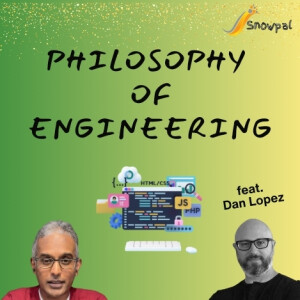
Friday Nov 15, 2024
Philosophy of Engineering (feat. Dan Lopez)
Friday Nov 15, 2024
Friday Nov 15, 2024
In this episode, Krish Palaniappan interviews Dan Lopez, an innovation executive and CTO at Neural Labs. They discuss the transformative potential of machine intelligence and its applications in various fields, particularly in risk assessment and environmental monitoring. Dan shares insights into the foundational technologies at Neural Labs, the importance of understanding customer needs, and the science behind satellite imagery. The conversation highlights the intersection of technology, data, and real-world applications, emphasizing the role of AI in enhancing decision-making processes.
Dan discusses the importance of understanding client needs when developing technology solutions, the market opportunities presented by AI, and the integration of new technologies with existing systems. He emphasizes the ethical considerations in technology development and the artistry involved in coding, highlighting the need for engineers to view their work as a creative endeavor.
Takeaways
• Machine intelligence is about augmenting human capacity.
• Neural Labs focuses on applying AI in real-life solutions.
• Understanding customer needs is crucial for product development.
• Proximity to risk is a key use case for AI applications.
• Insurance providers are primary customers for risk assessment tools.
• Satellite imagery can provide insights into environmental changes.
• Data from space can predict agricultural outputs and GDP.
• Risk assessment involves understanding complex interdependencies.
• AI can help navigate and mitigate risks in various sectors.
• The future of AI lies in its integration into everyday life.
• Understanding client needs is crucial for technology solutions.
• AI integration opens up new market opportunities.
• Technology must be built to integrate with existing systems.
• Ethical considerations are paramount in technology development.
• Coding should be viewed as an art form, not just a science.
• Engineers need to embrace creativity in their work.
• Communication with clients about AI capabilities is important.
• Market sizing is essential when developing new products.
• Augmentation of human intuition is key in technology design.
• Continuous learning and adaptation are necessary in tech development.
Chapters
00:00 Introduction to Dan Lopez and Neural Labs03:13 The Journey of Machine Intelligence06:05 Understanding Neural Labs' Solutions09:09 Proximity to Risk: Use Cases and Customers12:12 Engagement with Insurance Providers15:05 The Science Behind Satellite Imagery17:56 Connecting Data to Real-World Applications26:45 Understanding Client Needs in Technology Solutions29:58 Market Opportunities and AI Integration32:50 Building Technology for Existing Systems37:04 Technological Evolution and Ethical Considerations40:57 The Artistry of Coding and Technology
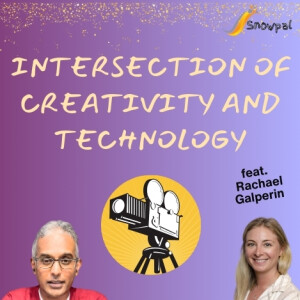
Friday Nov 15, 2024
Intersection of Creativity and Technology (feat. Rachael Galperin)
Friday Nov 15, 2024
Friday Nov 15, 2024
In this episode, Krish Palaniappan interviews Rachel Galperin, founder and CEO of Next Found Artist. They discuss the intersection of technology and creativity in the film industry, focusing on the challenges independent filmmakers face, including funding, distribution, and collaboration. Rachel shares insights into how her platform supports filmmakers by providing marketing assistance, community engagement, and a unique distribution model that emphasizes premium content. The conversation also touches on the importance of diversity in filmmaking and the role of short films in modern storytelling.
Rachael discusses the intersection of creativity and technology in filmmaking. She emphasizes the importance of a human review process, the need for diversity and inclusivity in storytelling, and the challenges independent filmmakers face in distribution and funding. Rachael shares insights into the upcoming features of their platform, the significance of community building, and the role of technology in enhancing the creative process. The discussion highlights the platform’s commitment to supporting filmmakers and providing a space for underrepresented voices in the industry.
Takeaways
• Next Found Artist empowers independent filmmakers.
• Diversity is crucial in the creative process.
• Marketing support is essential for filmmakers.
• Short films are gaining popularity among audiences.
• The platform focuses on community engagement.
• Funding is a significant challenge for creators.
• Collaboration opportunities will be available in 2025.
• Content must meet specific quality standards.
• The review process ensures premium content.
• The platform uses an ad revenue model for monetization.
• The review process currently involves multiple human reviewers.
• Next Found Artist aims to be a platform for filmmakers by filmmakers.
• Diversity and inclusivity are core values of the platform.
• The platform is focused on helping filmmakers find their audience.
• Distribution is a major pain point for independent filmmakers.
• Upcoming features include personalized viewing experiences.
• The platform emphasizes community building among filmmakers.
• Feedback from filmmakers is crucial for platform development.
• The platform aims to bridge gaps in accessibility for diverse stories.
Chapters
00:00 Introduction to Next Found Artist02:56 The Intersection of Technology and Creativity05:53 Challenges Faced by Independent Filmmakers09:00 Distribution and Marketing Strategies12:05 Funding and Financial Challenges14:59 The Role of Short Films in Filmmaking17:47 Collaboration Opportunities for Creators20:54 Review Process and Content Standards23:54 Community Engagement and Audience Connection30:00 The Review Process: Human vs. Automated32:13 Creative Insights and Upcoming Technology33:51 Filmmaker-Centric Approach: Understanding Needs36:13 Content Quality and Festival Routes38:01 Differentiating in a Crowded Market40:08 Unique Selling Propositions for Filmmakers41:52 Funding and Collaboration Challenges43:57 Technology Features and User Experience45:55 Distribution: The Key Pain Point47:51 Engineering Challenges in Platform Development49:54 The Role of Technology in Creativity51:51 Training and Community Building for Filmmakers53:48 Global Perspectives in Filmmaking55:51 The Driving Force Behind the Platform57:55 Marketing Strategies for Growth
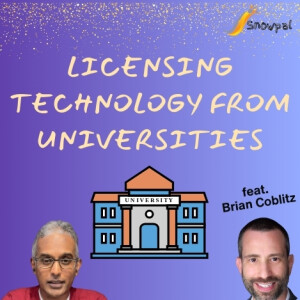
Thursday Nov 14, 2024
Licensing Technology from Universities (feat. Brian Coblitz)
Thursday Nov 14, 2024
Thursday Nov 14, 2024
In this episode, Krish Palaniappan speaks with Brian Coblitz, the executive director of the George Washington University Technology Commercialization Office. They discuss the intricacies of licensing technology from universities, the importance of building long-term relationships, and the challenges startups face when engaging with academic institutions. Brian shares insights on how to navigate the technology transfer process, the significance of understanding university research, and the collaborative opportunities available for startups.
Krish Palaniappan and Brian Coblitz delve into the intricacies of partnerships between startups and universities, focusing on the expectations of domain expertise, monetization strategies, revenue sharing models, and the importance of patent costs. They discuss the value proposition for startups in engaging with universities, emphasizing the innovative potential of university research and the critical role of product-market fit in successful technology transfer.
Takeaways
• Licensing technology is akin to renting an idea.
• Universities excel in basic research but not in product development.
• Building long-term relationships is crucial in technology licensing.
• Startups should reach out to university technology transfer offices for collaboration.
• There is no centralized database for available technologies to license.
• Understanding the right contacts in universities is essential for startups.
• Sponsored research can follow after a licensing agreement is made.
• The patent life is typically 20 years, necessitating long-term partnerships.
• Conversations with university offices can lead to valuable insights and opportunities.
• The process of technology transfer involves both protecting and marketing innovations.
• Domain expertise is crucial for partners in university collaborations.
• Startups are generally expected to fund the development process.
• Revenue sharing can include fees, royalties, and equity.
• Patent costs can be significant and need to be reimbursed early.
• Universities provide innovative research that can lead to viable products.
• Partnerships can help startups raise funding by leveraging university credibility.
Chapters
00:00 Introduction to Technology Licensing
07:56 Understanding Licensing Technology from Universities
15:45 Navigating University Partnerships
22:40 Bridging the Gap Between Research and Industry
29:12 Understanding Domain Expertise in Partnerships
32:00 Monetization Strategies in University Partnerships
35:49 Revenue Sharing: Fees, Royalties, and Equity
39:55 Navigating Patent Costs and Reimbursements
45:26 The Value Proposition for Startups in University Collaborations
56:17 The Role of Product-Market Fit in Technology Transfer
01:00:41 Navigating International Patent Filings
01:02:08 Understanding Startup-University Collaborations
01:03:32 The Role of Intellectual Property in Startups
01:05:29 University Goals: Building vs. Monetizing
01:07:05 Engaging with Universities for Innovation
01:09:57 Events and Resources for Entrepreneurs
01:12:36 Building Relationships with Local Universities
01:16:47 The Importance of Passion in Entrepreneurship
01:21:03 Global Perspectives on Technology Transfer







